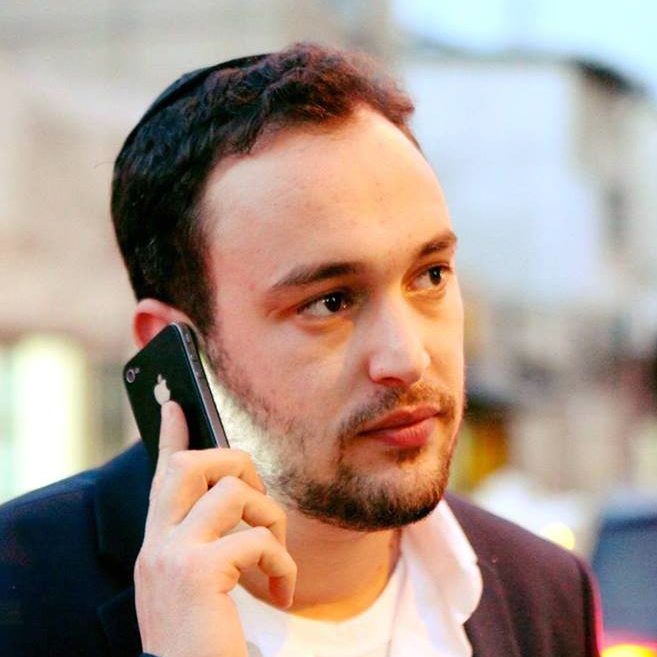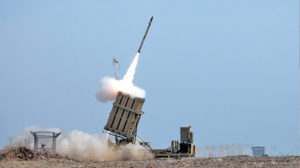Chopper Chase

In the skies with Israel’s police airborne unit

From above, where everything looks tiny sitting inside this Israel Police airborne unit helicopter, you can’t hear the nervous honking of edgy drivers, but we do have a panoramic view of one of the country’s most problematic roads: Route 60, which passes from the south through Chevron and Gush Etzion, takes a break in Jerusalem, and then continues north through the Shomron. The temptation to ignore traffic laws here, putting lives at risk, is great, as the heavily-traveled road consists of one serpentine lane in each direction for many miles, divided by a solid no-passing white line (with no meridian or barrier); there are lots of slow-moving trucks, and many of the drivers are residents of the Palestinian Authority who don’t care much for road safety rules.
Minutes pass. Traffic is slow. A heavy truck has turned onto the road and a long row of cars snakes behind it. Yossi immediately discerns the potential for danger. Private vehicles are tailgating the truck impatiently. Each one of them might be the first to cross the solid white line and pass the truck. And before the truck even traverses a few dozen meters of the incline, the drama begins. It happens suddenly, almost unintentionally. A car is speeding in the opposite lane, followed by a police patrol car. Yossi quickly checks on the police radio to find out what’s going on.
The answer comes in a few seconds. The driver of the vehicle was caught by the traffic cop’s radar, and when he set out after him, the speeder refused to stop.
Chief Superintendent Yossi Reuveni, an operations branch officer with the police airborne unit, is also on board the chopper. In a split-second, he decides to abandon the original surveillance mission in order to follow this developing chase. He asks the pilot to turn the helicopter around and not to lose the speeding car.
The police car is still chasing the driver, who obviously has no intention of stopping. He weaves in and out of traffic, back and forth across the white line, cutting off other drivers and barely averting cars coming toward him in the opposite lane, anything to avoid the cop who’s valiantly trying to close the gap. About a two-minute drive away from where this chase is unfolding, there are two patrol cars, and Goali, the airborne traffic cop, provides them with the necessary information.
“He’ll be by you in two minutes. Set up a roadblock,” he instructs. We watch as traffic cops and the patrol cars spread out, waiting for the driver to hit the intersection.
Just a few meters away from the intersection, the driver notices the patrol cars. Upping his speed, he manages to wend his vehicle between the patrol cars, guns the gas, and careens left into a nearby Palestinian village.
The chasing patrol car stops. Entrance to this village needs joint PA approval. On the police radio, they recalculate. “Track him and get a license plate number,” an officer on the ground tells the men in the helicopter.
The helicopter hovers over the village, but it doesn’t look like the driver notices. He stops the car just after the entrance, where a friend, who he apparently notified, is waiting for him. The runaway driver jumps into his friend’s car, and soon they’re out of sight. A minute later, someone else gets into the runaway car and he too drives off into the village. Stolen car? That’s for the police to figure out. Yossi Goali has the license plate number and passes it on to headquarters.
“Okay, we’re done here, Nechemiah,” Reuveni tells the pilot. “Turn around, please. Let’s get back to work.”
TOTAL ACCESS
Many Israelis don’t even know the police airborne unit exists, even as its helicopters frequently hover over the country’s citizens. And those who do usually associate police helicopters with crowd control at huge events, such as mass tefillos at the Kosel, Lag B’omer in Meron, or crowded political rallies. But the unit’s choppers are in the air day and night providing a wide range of functions — from searching for missing people to dealing with terrorist activity, from enforcing traffic laws to destroying illegal structures. Israel Police’s sky-based officers might be hidden in the clouds, but their activities several thousand feet above, with Hashem’s help, protect the ground on a daily basis.
Yossi Reuveni, a veteran policeman and airborne unit operations officer, explains that the unit was originally started in the early 1950s with several aircraft, but was shelved after a company tragedy and didn’t reactivate until the early 1990s.
“In 1956, one of the planes crashed. It was right after the end of the Sinai Campaign, and Chief of the Southern Command Assaf Simchoni, who was the battle commander, went out with a pilot named Benny Gordon for a flight on a police aircraft. On the way, the plane somehow deviated from its path and crashed over Jordanian territory. Simchoni and Gordon were killed, and this tragedy remained seared in the police conscience for many years. A short time later, the airborne unit was closed.”
In the intervening years, the police would lease a private helicopter whenever it was needed. Reuveni recalls how “before a mission, we would paste the police logo on it.” Following a reassessment of the police force’s needs, the unit was reopened in 1992, with separate bases in the north and south of the country. “The objective was to be accessible to every event in the shortest possible time,” Reuveni explains.
In addition to six helicopters, the unit has fourteen firefighting planes, which are generally deployed during the dry, scorching summer months when fires can be especially hard to control. The firefighting squadron was established after the devastating Mount Carmel forest fire in December 2010, the deadliest fire in Israeli history, claiming 44 lives — most of them Israeli Prisons Services cadets who were trapped on a bus on the way to evacuate prisoners from the path of the inferno. Today the squadron, which was initially part of the Air Force before being transferred to the police, provides airborne backup to make sure fires don’t escalate into catastrophic situations.
The firefighting planes notwithstanding, the police helicopter can reach any location in the country within 15 minutes of receiving a call, which is significant with a developing fire, even if it starts out small. The helicopter accompanies the plane, managing the event from an aerial control center that flies above the firefighting aircraft.
“The helicopter can also dump 600 liters of water, when necessary, which it draws from any water source in the region of the fire,” says Reuveni. “And it’s ability to hone in with surgical precision is significant when a firefighter or civilian is in critical danger. It also provides a picture of the entire area where the fire is raging and heading, so we can guide the planes in that direction to prevent widespread damage. In essence, the helicopter is our eyes in the field.”
Sky Supervision
All the unit’s pilots are Air Force graduates, and they have to be ready at a moment’s notice. “Deployments can come with warnings of mere minutes,” Reuveni explains. “It could be when we’re chasing a car thief, or when a riot breaks out without any advance notice. True, most of our activities are initiated, whether they relate to enforcement or supervising planned events, but just like patrol cars are alerted dozens of times a day to events that unfold from minute to minute, so are our helicopters. When I get a call to send a helicopter, I have just one consideration: How much time will it take to get to the scene? If I can get there in time to be relevant, then my pilots take off.”
This morning’s excursion, however, is initiated. Every few days, the airborne unit sends up helicopters to enforce traffic laws and catch offenders. The helicopters work in tandem with the patrol cars on the ground — from up in the air, they report clearly visible violations and relay that information to the ground patrol, who then stops the driver.
“I work on the roads as well as the sky,” says Yossi Goali. “Our advantage is that according to the law, there has to be a witness to a traffic violation, and the offender has to be in our field of vision until the ticket is issued. That’s why I keep my eyes on the car until our patrol car stops him and gives him the ticket. This might seem petty, like why are we trapping these unsuspecting drivers? But I’ll tell you why — because each year we’re witness to a massive rise in the number of fatalities from road accidents. Our enforcement focuses on dangerous violations, such as illegal passing and risking being smashed by an oncoming vehicle.”
We don’t have to wait long to see it in real time. A very slow truck is driving beneath us, and some of the cars behind it are clearly agitated. Goali is hyper-focused. In a flash, three cars take advantage of a lull in the traffic in the opposite lane and pass the truck. They quickly pick up speed as they dart into the opposite lane, but what they don’t see is an oncoming car racing down from around the bend. We’re a hairsbreadth away from catastrophe. At the last second, the passing cars slip back into their lane — seconds separating a close call from a head-on collision. Goali quickly records the time of the pass and reports to a patrol car stationed a few minutes away that offenders are headed in his direction.
“Three cars,” he reports, all the while keeping his eyes glued to the offending vehicles so as not to lose sight of them. “A taxi, a black car, and a gray car, one behind the other. Ahead of them is a white Nissan. They’ll get to you in two minutes.”
At the next intersection, the patrol car is waiting. He stops the three drivers, one by one, while the helicopter hovers above so the offenders can see there was a witness to their transgression. They’re nailed. Only then can we continue on.
“Every time one of these operations succeeds, I think about the cases we don’t catch — where reckless drivers literally cause carnage on the roads,” Goali says. “If I can deter one of these drivers, then I’m happy.”
No Heroics
A helicopter squad, viewing the terrain from a different angle, has other advantages when it comes to fighting crime. They can spot activities relating to nationalistic crimes; track down wanted criminals; collect information before an operation is implemented; spot the camouflaged growing and production of addictive, illegal substances; and other actions in which a helicopter has an advantage over a patrol car on the ground.
“Let’s say there’s a terror attack in Jerusalem,” Reuveni says. “Even if it seems that it’s over and the terrorist has been neutralized, it often happens that when questioning the victims we learn that there was someone else at the scene or that someone fled in a vehicle. We can then manage the event from above. Even if the terrorist is dead, is there anything else going on in his house? What’s happening in the mourners’ tent? In his village?
“We also get called in when there’s an incident of a missing person,” Reuveni continues. “It often happens during bein hazmanim, but not only. We recently participated in a search for a man who went with his children to Nachal Dragot and couldn’t find their way out before nightfall.
“In such a situation, the helicopter is able to get into places where others can’t. We locate the missing person and then guide the rescue personnel on the ground how to navigate until they reach the stranded people. But the truth is, most of our work doesn’t get much acclaim, because there is no heroic arrest at the end, or a nail-biting rescue that everyone was watching with bated breath. We do our work out of the limelight, with little publicity. So our satisfaction is our measure of success. We know that without our work, many events would end differently.”
Beneath the Radar
“The ability to see from above is the best tool and weapon,” says Israel Police’s airborne unit director, Nir Rosenthal. He’s referring both to the unit’s helicopters, and to the drones that the police have been using in recent years for a variety of operations: “Searches, photographs, maintaining public order, enforcing traffic laws, documenting transactions of illegal substances, and more. We have about 150 drones all over the country, which can direct the ground team until a helicopter arrives.”
I asked Rosenthal about the most dramatic event his unit has dealt with this past year. “Well, there have been hundreds of events,” he says, “But I would say the most challenging was the wave of fires over the summer, some from negligence or accident, some from arson and terror. There was one week alone in which we sent up 300 helicopter sorties during which we dropped 900,000 liters of fire retardant and water on active fires.”
But Rosenthal says he’s not looking for drama — he’d prefer to concentrate on deterrence. “Our hope is that with the preempting of tragedy on the one hand, and the aid we give the ground forces on the other, we’ll ensure calm on all fronts. Because ultimately, our job is to make sure that all citizens can live a normative life and mitigate senseless injury or death. Isn’t that worth a traffic ticket?”
(Originally featured in Mishpacha, Issue 792)
Oops! We could not locate your form.












